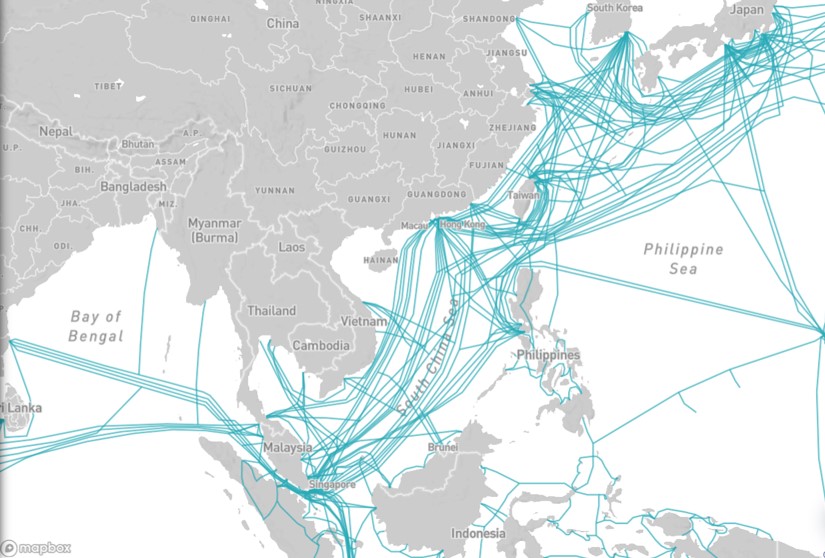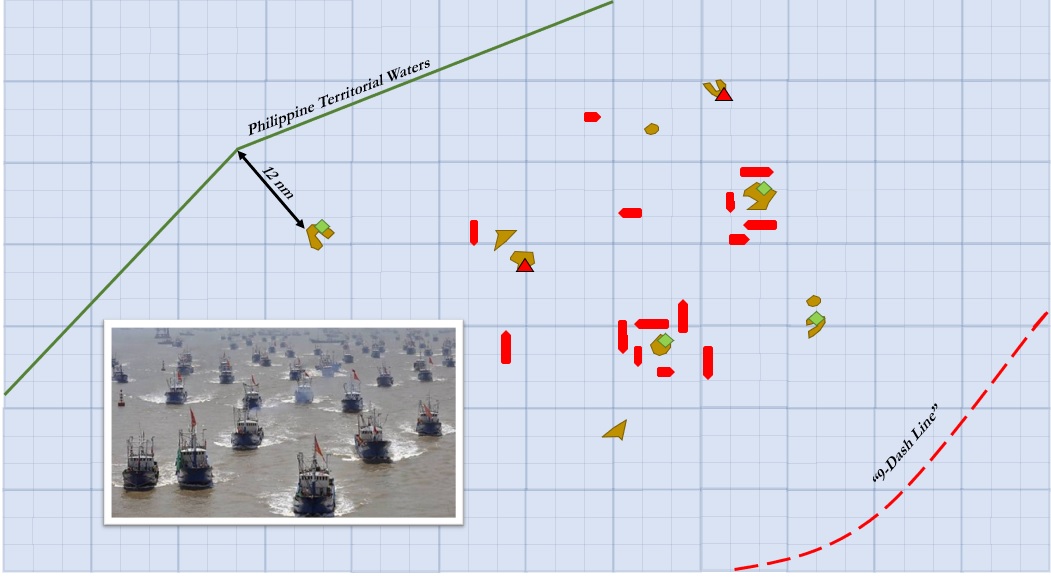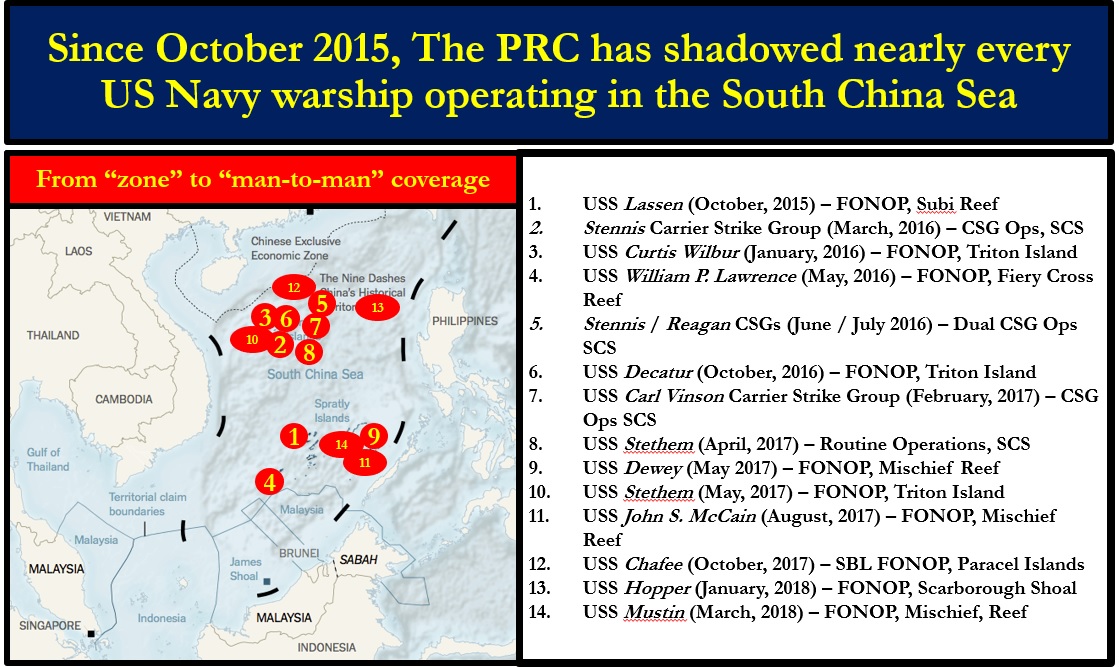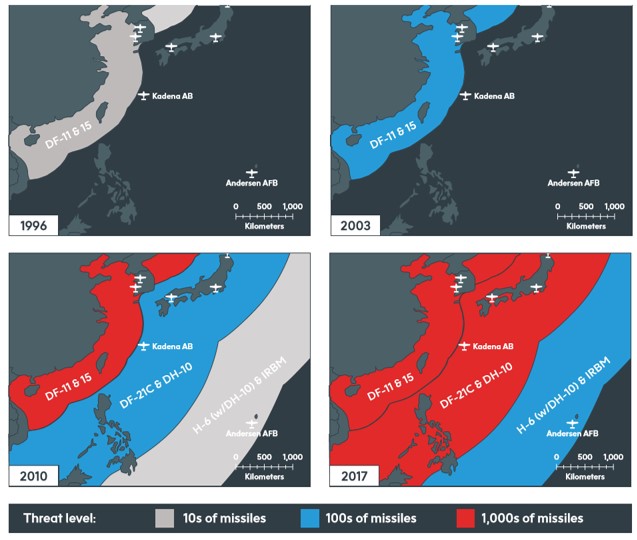Charting a New Course for the Navy-Marine Corps-Coast Guard Team
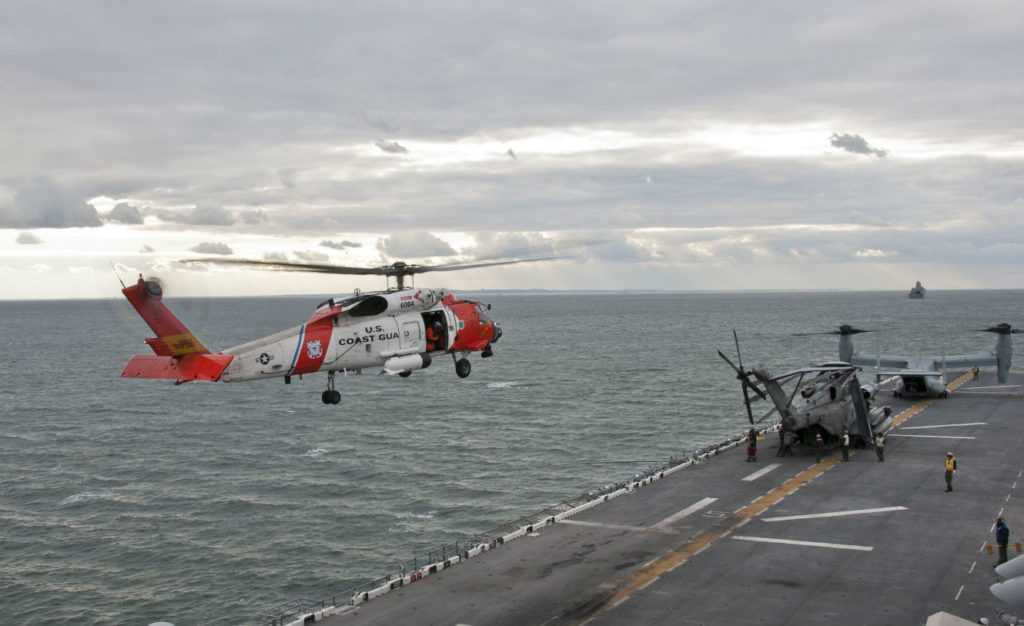
“China and Russia want to shape a world antithetical to U.S. values and interests. China seeks to displace the United States in the Indo-Pacific region, expand the reaches of its state-driven economic model, and reorder the region in its favor.”
–2017 National Security Strategy of the United States of America
“There simply is no way to do deterrence by denial … particularly in the Indo-PACOM theater … unless we find a way to get more Navy-Marine Corps tooth into the blunt and contact layers, right? But then the question becomes, to your point, Mr. Secretary, what’s the right mix of tooth? What’s the right mix of ships, and sailors and marines? And what’s the overall cost? Because it doesn’t need to be all carriers.”
–Rep. Mike Gallagher, House Armed Services Committee Department of the Navy posture hearing, April 10, 2019
The annual Department of the Navy posture hearings recently concluded at the Senate and House Armed Services Committees without much more than a whisper. Throughout the hearings, a common theme among the department’s most senior civilian and military leaders was that the Navy and Marine Corps are working closely, cooperatively, and aggressively together to implement the 2018 National Defense Strategy. As naval service professionals, we can certainly attest to the fact that sailors, marines, and coastguardsmen are thinking deeply about the implications of both the 2017 U.S. National Security Strategy and 2018 National Defense Strategy. At the same time though, we also believe the naval services can — and should — be doing much more together to translate this guidance into a new naval strategy.
At present, diverse voices from across the Navy, Marine Corps, and Coast Guard are debating the core strategic concept to inform this strategy. In a 1954 Proceedings article, Samuel Huntington argued that “the fundamental element of a military service is its purpose or role in implementing national policy. The statement of this role may be called the strategic concept of the service. Basically, this concept is a description of how, when, and where the military service expects to protect the nation against some threat to its security.” Strategic concepts invoke new theories of victory and describe how a service, or in this case the Department of the Navy’s combined naval services, should align concepts, capabilities, and force structure in pursuit of political objectives.
Lest anyone doubt the extent of this search for a strategic concept, we recommend spending a few hours reading recent works from naval service professionals such as Dale Rielage, James Fanell, Jerry Hendrix, BJ Armstrong, Noel Williams, Art Corbett, John Berry, Leo Spaeder, Brian Kerg, Mark Nostro, Bryan McGrath, and co-authors Frank Hoffman and George Garrett. You can also add articles by Lt. Gen. Mike Dana, Under Secretary Thomas Modly, and Adm. (ret.) James Stavridis to the list. Clearly, there is no shortage of opinions on the recommended destination and waypoints of our naval services. We trust that even the most positive-spirited, “can do” War on the Rocks’ readers will sense, however, a palpable lack of cohesion within the Department of the Navy. Still, the rash of articles are indicative of a deep dialogue among passionate professionals, ultimately suggesting the naval services are starving for a clear strategic concept.
We propose a more deliberate approach. This article describes three actions that we recommend occurring between today and the Fiscal Year 2021 Department of the Navy posture hearings next spring. These actions will help demonstrate to the American people that the naval services are indeed, from top-down and bottom-up, doing everything possible — together — to implement the National Defense Strategy.
#1: Establish an operational planning team to produce a Naval Strategy to share with America within the next three months.
Fifteen months have passed since the National Defense Strategy’s publication. Over the intervening period, the bipartisan National Defense Strategy Commission described in its final report that “the security and well-being of the United States are at greater risk than at any time in decades.” The commission also observed that U.S. military superiority — “the hard-power backbone of [America’s] global influence and national security” — has eroded to a troubling degree. For these and myriad other reasons, the commission agreed with the National Defense Strategy’s tone and the vector for the Defense Department. However, the commission also shared its serious concerns with what it identified as one of the National Defense Strategy’s primary deficiencies: “[it] rightly stresses competition with China and Russia as the central dynamic in sizing, shaping, and employing U.S. forces, but it does not articulate clear approaches to succeeding in peacetime competition or wartime conflict against those rivals.”
Since the National Defense Strategy’s publication, some organizations within the Pentagon have moved out in a manner that addresses the commission’s concerns. Consider the Department of the Army: Over the past eight months, the department’s civilian and military leaders approved a new Army strategy, along with the “U.S. Army in Multi-Domain Operations 2028” concept, both of which are tightly linked with the National Defense Strategy’s guidance. They subsequently “scour(ed) every corner and crevice of the Army budget” in a series of “Night Court” proceedings to maximize the potential to achieve both. We’ll cover more on the “Night Court” proceedings later in the article. Suffice it to say, these proceedings involved making hard force structure, organizational design, and acquisition program divestment and investment choices, such as the decision to halt Bradley fighting vehicle production and upgrades by 2023, along with future CH-47F Chinook procurement. And most importantly, these proceedings have enabled senior Army leaders to go on a full-court press campaign with their soldiers, the American people, and Congress explaining the logic behind their decisions, including requests for new capabilities.
One could argue that the last example of such a guidepost for the Department of the Navy was A Cooperative Strategy for 21st Century Seapower (CS21), or what was commonly referred to as the U.S. maritime strategy. Originally published in 2007, with endorsement signatures from the Secretary of the Navy and all three service chiefs of the Navy, Marine Corps, and Coast Guard, CS21 cited “changes in the security and fiscal environments, along with new strategic guidance … mandate[d] an updated maritime strategy.” This maritime strategy provided a broad overview of the strategic problems that the sea services were thinking about how to solve together.
While certainly an important document, given its lack of detail, we do not believe CS21 provides the appropriate template for how to approach the currently required strategic concept. The 1982 Maritime Strategy and its 600-ship Navy provide a much better historical precedent. The secretary of the Navy at the time, John Lehman, “insisted that the Navy have, promulgate, and follow a STRATEGY.” This strategy was based on a logic that “we had a finite number of geopolitical regions in which our vital interests demanded command of the seas to ensure deterrence of the Soviet threat by sufficient naval forces to convincingly defeat Soviet forces if war broke out.” Lehman also believed that “he must constantly explain and articulate his strategy, his objectives, and his vision to Congress, to the Sailors and Marines, and to the American people.” And equally important, the Maritime Strategy provided, as one of its primary contributors described, “a vehicle for the professional military … to apply sound strategic thinking to the solution of national problems.”
To our knowledge, the Department of the Navy has yet to produce a similar guiding, unifying, and prioritizing subordinate strategy of the National Defense Strategy that explains to the American people how the Navy-Marine Corps-Coast Guard team will — together — enable protecting U.S. national security interests in 2019 and beyond. One might argue that recent operational concepts, such as Distributed Maritime Operations, Littoral Operations in a Contested Environment, and Expeditionary Advanced Base Operations are intended to provide the proposed guiding and unifying vision. But these concepts were largely envisioned and drafted, at best, simultaneous to the National Defense Strategy, opposed to being derivatives of the guidance. Moreover, these documents were largely drafted within the respective services without the benefit of thorough naval service integration throughout the process. More important, as of today, these concepts lack resource prioritization decisions arbitrated by the Department of the Navy to ensure that they can be actualized. In the end, the presence of service chief co-signatures and a few token marines or sailors on each other’s staffs are not indicative of true integration. In many ways, this family of concepts problematically conveys separate, even if often similar, naval service visions for operating in the future.
Such individual service-biased approaches are problematic for many reasons, not the least of which is because neither the Navy, Marine Corps, or Coast Guard can accomplish its mission, especially in the Indo-Pacific — the National Defense Strategy’s priority theater — without the other services. The nation’s competitors are adeptly maneuvering to gain advantage across the entirety of the conflict continuum. The waters in the Indo-Pacific are bigger than all of the land on earth combined and are amongst the most strategic littoral regions in the world for U.S. national security. If required to counter a fait accompli strategy in the Western Pacific’s littoral regions, these waters’ vast expanse also present innumerable problems for U.S. policymakers — unless the Navy-Marine Corps-Coast Guard team is already appropriately forward-positioned and postured to deter by denial the competitor’s theory of victory.
Naval warfare experts Capt. Wayne Hughes and Rear Adm. Robert Girrier reinforce these points in their seminal work, Fleet Tactics and Naval Operations. They explain that “American warships depend for survival on out-scouting the enemy and attacking him not only effectively, but decisively first. These are tactics suitable for a fleet in the open ocean.” They also explain, however, that these “tactics will lose their efficacy in littoral waters.” Or, in other words, for the Navy-Marine Corps-Coast Guard team to effectively protect U.S. national security interests in littoral regions such as the Strait of Malacca, South China Sea, and East China Sea, the services must work together.
For all the above reasons, we recommend the secretary of the Navy form an operational planning team to produce a finalized Naval Strategy within the next three months. Far from being another glossy guidance document, the strategy — created under the direct guidance of the secretary of the Navy and with constant collaboration between the naval services — will explain what the future fleet, as an integrated Navy-Marine Corps-Coast Guard team, will do to implement the National Defense Strategy. This timeline will also enable the incoming chief of naval operations and commandant of the Marine Corps to anchor their forthcoming service-level planning and programming guidance appropriately. Importantly, given the economic significance of unimpeded access to critical sea lanes and maritime infrastructure, and the increasing number of territorial disputes and emphasis on maritime law enforcement in places like the South China Sea and in the Arctic, we can envision numerous reasons to elevate the strategy to a new U.S. Maritime Strategy inclusive of all three naval services.
#2: Ensure the proposed Naval Strategy aligns with Navy, Marine Corps, and Coast Guard Title 10 responsibilities and, if necessary, recommend appropriate Title 10 updates to allow accomplishing the National Defense Strategy goals.
A few of the aforementioned authors raised serious questions about service identity and even the purpose of the military in the information-age vice industrial-age of warfare. Rielage provided a disturbing account focused primarily on the U.S. Navy and “How We Lost the Great Pacific War” in 2025. Spaeder requested for the incoming commandant of the Marine Corps to answer, “Sir, who am I?” based on his confusion about the “dizzying array” of ideas being offered about the Marine Corps’ future. Lt. Gen. Dana took this to a whole new level when declaring, “we’re ill-prepared for the next war … because we are not adapting to the changing character of warfare … moving from industrial-era warfare to information-era warfare, which is making legacy bureaucratic process and military organizations obsolete.” Adm. Stavridis explained that after China’s successful militarization of the South China Sea, its next “naval target is the internet’s undersea cables,” including the “thousand or so ground-based landing stations” located in the world’s littorals. He concludes his article quoting a recent observation from Adm. James Foggo: “underwater cables are part of our critical infrastructure and essential to the global economy. The U.S. must protect the integrity and security of them as surely as we provide international freedom of the high seas.” In reviewing where these cables and their ground-based landing stations are located, one might ask, what better force than an integrated Navy-Marine Corps-Coast Guard team to safeguard key maritime terrain?
Figure 1. Undersea cable and ground-based landing station locations in the Indo-Pacific. American companies have invested billions of dollars on this infrastructure (Source, Infrapedia).
However, safeguarding key maritime terrain likely requires specifically re-imagining the Navy-Marine Corps team’s vision and force design requirements to accomplish current understandings of Title 10 responsibilities “to provide fleet marine forces of combined arms … for service with the fleet in the seizure or defense of advanced naval bases.” Problematically, the common interpretation of these responsibilities generates mental images rooted in large-scale amphibious, forcible entry operations to secure land — a method mostly outlined by the “Chowder Society” 72 years ago and long before the U.S. Navy and Coast Guard had daily access to many dozen mutual defense treaty ally and strategic partner ports. Neither the Marine Corps nor Navy’s Title 10 responsibilities effectively capture — at least based on currently accepted understandings — what happens when the naval campaign is not one that starts after an adversary crosses certain armed conflict escalation criteria, but rather one that persists below the level of armed conflict, 24/7/365.
Figure 2. China’s “Cabbage Strategy” in execution, including the use of hundreds of maritime “militia” vessels (Source: Authors).
For example, is it a realistic ask for the naval force to protect key infrastructure such as Amazon, Google, Facebook, and Microsoft’s billions of dollars in undersea fiber lines, ground-based landing stations, and intellectual property moving through the world’s increasingly congested and contested key littoral maritime terrain? These regions include the South China Sea, where the People’s Liberation Army Navy is, and has been for years now, waging a persistent, coercive, “gray zone” naval campaign, often referred to as a “Cabbage Strategy,” focused against a U.S. mutual defense treaty ally, multiple strategic U.S. partners, and U.S. naval vessels as well.
Figure 3. People’s Liberation Army Navy actions in the South China Sea since 2015 (Source: James E. Fanell’s ‘Asia Rising: China’s Global Naval Strategy and Expanding Force Structure’)
And while the Arctic is still by-and-large a cooperative space, Russia’s recent proposed rules for Northern Sea Route access depart from international norms. Considered in context of their continued build-up of military capability at these latitudes, increased economic activity in the region creates power dynamics and risk of conflict similar to those roiling the waters in the South China Sea. Russia is also not the only competitor vying for increased influence and control in the region. The Pentagon’s 2019 report to Congress on China describes Beijing’s active efforts to increase its access to the region, including through building a “Polar Silk Road.”
Given such challenges, we believe the naval services have a strategic opportunity before them, one which can help answer Rep. Mike Gallagher’s and others consistent requests. The opportunity is to recommend to Congress, perhaps as part of the forthcoming House Armed Services Committee Future Defense Task Force, an updated interpretation of the more than half-century old service Title 10 responsibilities. Perhaps the operational planning team would find it beneficial to update Title 10 verbiage. As just one example, “for service with the fleet in the seizure or defense of advanced naval bases” could potentially be updated with a more applicable intent of “for service with the fleet in the seizure, defense, and/or deterrence-by-denial of key maritime terrain.” Such a wording change would likely drive naval professionals to think deeply about how best to employ the Navy-Marine Corps-Coast Guard team “below the threshold of armed conflict.”
In either case, the updates would seek to accurately account for Adm. Stavridis’ observations on the importance of the world’s key littoral regions and increasing number of undersea cables and ground-based landing stations within them. They would also account for the essential, symbiotic relationship required between the Navy-Marine Corps-Coast Guard team, including each of the service’s cyber forces that some have questioned recently, to effectively and persistently protect U.S. national security interests in these regions. After all, the naval services capable of executing such missions on behalf of the American people today — protecting trillions of dollars in U.S. economic strength — are far more important than continuing to spend more than $205 billion on a Navy-Marine Corps team, which many believe still anchors its force design foundation on large-scale amphibious assaults that policymakers have not ordered to be conducted in the past 69 years. Moreover, a determined Department of the Navy commitment to executing this vital mission would inevitably lead the Navy and Marine Corps to no longer advocate for the “compromised fleet architecture” that Noel Williams recently described in his War on the Rocks’ article.
#3: Similar to the Army’s “Night Court” process, develop a prioritized Department of the Navy divestment and investment plan to enable accomplishing the new Naval Strategy.
“What the United States fears the most is taking casualties … the loss of one super carrier would cost the U.S. the lives of 5,000 service men and women. Sinking two would double that toll … We’ll see how frightened America is.”
–Rear Admiral Lou Yuan, Deputy Head of the Chinese Academy of Military Sciences, December 20, 2018
The “Night Court” process has already led to major changes across the Department of the Army. For example, detailed reviews of more than 500 acquisition programs resulted in identifying more than $8 billion in cost avoidance measures, reforms netting around $22 billion in savings, and decisions to divest of more than 90 programs, while reducing acquisition goals in an equal number of other programs. Additionally, Army leadership decided to slow projected end-strength goals, slimmed the size of headquarters and administrative functions, and as mentioned earlier, incorporated the analysis as part of the organization’s full-court press campaign to explain how the department needs to change to heed the National Defense Strategy guidance.
While we believe it is imprudent to offer concrete recommendations on future Department of the Navy divestment or investment decisions without a new Naval Strategy and serious considerations of modern-day roles and missions, we think a series of core questions should help inform the effort. For example, given that the National Defense Strategy is built on a long-term competitive strategy foundation, with associated cost-imposition goals, is it wise to continue prioritizing new $13 billion aircraft carriers when China can field around 1,230, 1,000-plus mile range, all-weather, mobile, ground-launched missiles to strike each one?
Figure 4. China’s land attack capacity growth between 1996 and 2017 (Source: Eric Heginbotham et al., The U.S.-China Military Scorecard: Forces, Geography, and the Evolving Balance of Power, 1996–2017, RR-393-AF, RAND Corporation, September 2015.)
Additionally, given the size of the Indo-Pacific and its extensive maritime challenges, should the Marine Corps continue advocating for twice as much procurement funding for traditionally-manned, short-range aircraft as it does for amphibious ships of any type? With the growing import of assured access in the Arctic, is the current lack of infrastructure and pace of icebreaker acquisition leaving the nation in a stern chase of its competitors? Given the near constant and growing cyber threats to both U.S. civil and military infrastructure, how should the Department respond to Rep. Seth Moulton’s concerns that “we’re investing 16 times more in carriers than in cyber” or that unmanned ships are not included in the Navy’s Force Structure Assessment? Equally important, how should the Department respond to his concerns about “our massive financial commitment to the F-35,” along with Rep. Jim Banks recent questioning of F-35 operating costs in particular, specifically after hearing that the service that was once thought of as the “penny pinchers” allocated $51,300 per F-35B flight hour last year? One might also ask, “is it wise today for the Marine Corps to be requesting even more Joint ‘Light’ Tactical Vehicles when the U.S. Army is asking for fewer due to their weight, lack of relevant mobility, and cost?” These are just a handful of questions that should be asked in the Department of the Navy’s proposed “Night Court” proceedings.
Simultaneously, the “Night Court” proceedings should focus on what capabilities are fundamentally necessary to accomplish the intent outlined in the National Defense Strategy, to include executing a deterrence-by-denial strategy in the priority theater. Tackling this latter topic alone would likely lead the naval services to the conclude that 355 ships are not the solution for the required Force Structure Assessment, and that perhaps more than 1,000 are actually required, including hundreds of unmanned and autonomous ones. Members of this co-author team have shared ideas on this and related subjects in previous War on the Rocks and Marine Corps Gazette articles. These might serve as a useful point of departure. Given the relatively low-cost associated with the proposals in these articles, we are confident that the Department of the Navy would be able to find funding to implement the ideas — if it first executed a ruthless “Night Court” assessment of current acquisition programs and determined whether they help enable the National Defense Strategy and proposed Naval Strategy.
Strategic Opportunity
“Is the United States capable of grand strategy? Two centuries of American engagement with Asia and the Pacific strongly suggest that the answer is yes. American grand strategy has been episodic and inefficient, but in the aggregate it has been effective. The American people have repeatedly mustered the willpower, focus, and resources to prevail when access to an open order in the region has been fundamentally challenged … .”
–Michael J. Green, By More Than Providence: Grand Strategy and American Power in the Asia Pacific Since 1783
Under Secretary Modly recently emphasized in a Defense News article the importance of seapower to America’s future security and prosperity. We, of course, are in complete agreement with his analysis. For as then-Gen. George Washington stated, “without a Decisive Naval force we can do nothing definitive, and with it everything honourable and glorious.”
This said, it is critical for the naval services to move far beyond platitudes. The Navy, Marine Corps, and Coast Guard require a new, Department of the Navy-directed Naval Strategy, with clear Title 10 responsibilities articulated and interpreted for the world in 2019, along with specified divestment and investment priorities. Without this, House and Senate Armed Services Committee members will continue finding themselves asking how the future fleet will help achieve U.S. national security objectives — and America’s great power competitors will benefit. With this, however, the intellectual energy and passion for defending the American people within each and every sailor, marine, and coastguardsman will be unleashed toward a common purpose — and, as a result, the American people will continue to be safe and prosperous for generations to come.
Jeff Cummings is a Marine infantry officer and currently serves on the faculty of the Expeditionary Warfare School, Marine Corps University.
Scott Cuomo is a Marine infantry officer and MAGTF planner currently participating in the Commandant of the Marine Corps Strategist Program at Georgetown University.
Kathleen R. Dagher is an officer in the U.S. Navy. She has served with the Marines in Fallujah and Al Taqaddum and also worked for CD&I and OPNAV for future capability development. She has a BA in International Economics, an M.S. in Health Services Administration, a Masters in Military Studies, and a Master of Operational Studies from the School of Advanced Warfighting.
Austin Duncan is a Marine Intelligence Officer and Technical Information Operations Planner.
Gordon Emmanuel is a Marine infantry officer currently serving as a battalion executive officer.
James George is a Navy submarine and intelligence officer currently assigned to Expeditionary Strike Group 3.
Benjamin Jensen holds a dual academic appointment at Marine Corps University and American University, School of International Service and is a senior fellow at the Atlantic Council. He is the co-author of the recent book, Cyber Strategy: the Evolving Character of Power and Coercion. Outside of academia he is an officer in the U.S. Army Reserve, 75th Innovation Command.
Shawn Lansing (@cgrsqswmr) is an active duty Coast Guard officer currently assigned to Coast Guard Headquarters in Washington, D.C.
Torey L. McMurdo is a naval officer, Ph.D. candidate at Yale University, and pre-doctoral fellow at the U.S. Naval War College’s Cyber and Innovation Policy Institute.
Ryan Pallas is a Marine aviator and currently serves in the Indo-Pacific theater as the Operations Officer for Marine Heavy Helicopter Squadron 463 at Marine Corps Base Hawaii.
Noah Spataro is a Marine unmanned aircraft systems officer currently serving as the commanding officer of VMU-1.
The views expressed in this article are those of the authors and do not reflect the official policy or position of any of the naval services, the Department of the Navy, or the Department of Homeland Security.
Image: U.S. Navy photo by Mass Communication Specialist Seaman Markus Castaneda


